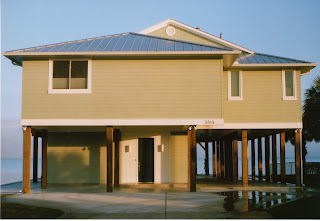One of the many perks of my marriage is the right to a once-
a- month reservation at “The
Property,” her family’s house on Galveston Bay. An hour from Houston, and a long way from its hustle and bustle,
the house offers ample space for holiday reunions and a site for solitary
idylls for the rest of the year. I
write with the Memorial Day get together fresh in my mind.
In the early 1970s my wife’s parents located the site and
built a house with an unoccluded view of the west bay and adjoining marshlands,
a glorious prospect, especially at sunset. Upon their deaths the deed passed to their four children,
who equally share rights and responsibilities. The original house was severely
damaged by Hurricane Ike, so much so that rebuilding seemed preferable to
reconstruction. My brother-in-law, a talented designer, oversaw the project, making
it larger and more hurricane resistant and incorporating a number of improvements
to the original floor plan. One of
the many first cousins did the construction. So now we have great views and
deluxe accommodations, and the cousin has a chunk of change.
Photographs taken over the years document changes to the
marsh and to the neighborhood. Like a receding hairline, the marsh has slowly lost ground to the
bay. A futile attempt to impede
erosion left behind undulating segments of a breakwater fashioned from a
cloth-lined tube stuffed with earth.
Birds and intrepid anglers sometimes perch on its slippery surface. The
spit of land that includes The Property has seen subdivision of some of the
original lots and increasingly dense occupation, with one fortuitous
exception. A prosperous neighbor
to our east bought and leveled a house that once stood between our property and
his. This provides us additional privacy as the prosperous neighbor is
seldom in residence.
In an elegantly written history he calls The Gulf, Jack Davis recounts human depredations of marine resources in the "fishy sea." We have played bit parts. Twenty years ago family weekends always began by laying crab traps in shallow water. Sometimes we dragged the bay bottom with a twenty foot net deployed over the side of our power boat. The haul, not always carefully culled for juveniles and females, filled our plates. But our improvidence contributed
to a sharp decline in the crab population, and the onset of old age has
diminished our zest for fishing.
We no longer own a powerboat, and our kayaks often rest peacefully in
the garage. Luckily a seafood market has located nearby, and my wife and in laws are
excellent chefs. The holiday
routine revolves around cooking, eating, drinking and getting
ready to repeat the cycle.
An interest in birdlife has offset our decline as
watermen. On the bay brown
pelicans, black skimmers, laughing gulls, and several species of terns demonstrate their hunting skills. Skimmers, as
their name implies, fly close to the water, their lower mandibles extended just below the surface to vacuum up small fish. Pelicans and terns dive from the sky, the former making a loud splash, to capture prey from above and then swallow it whole. We are sometimes lucky enough to see osprey, an eagle whose
technique is to snatch fish near the water surface before butchering them on a
safe perch. Gulls scavenge,
grabbing flotsam from the water, pestering hunters for part of their catch, or
demonstrating remarkable aerobatics chasing bits thrown into the air by our
delighted nieces.
Marshlands provide cover for shier, less agile fliers. Herons and egrets wade through the
shallow water searching for fish and crustaceans that they spear with their
long, sharp beaks. My wife and I
recently saw a giant blue heron with a large, wiggling snake at the end of its
bill. Roseate spoonbills are unmistakable in their deep pink plumage,
especially striking during mating season, and their characteristic feeding
behavior, swinging spatulated bills back and forth to capture small
animals and insects from the shallow water. Birds heard but unseen include the American bittern and the
Clapper rail, the latter prized by our expert bird watching friends.
Galveston Island, although small, low, and close to the
Texas mainland is an important stopover on the biennial bird migration to and
from the neotropics. Two years ago
we witnessed what birders call a “fall out.” Songbirds had exhausted their
energy reserves flying across the 650 mile-wide Gulf of Mexico, and the headwinds from cold
front forced them to land abruptly. Baltimore orioles, Prothonotary warblers, painted and indigo buntings, ruby
throated humming birds, arriving in singles and pairs, dropped almost
simultaneously one afternoon and immediately grazed watered lawns and oleander
hedges. It’s hard to conceal
bright orange, indigo, and red against brown and light green cover, so the
birds moved in plain sight. They
sucked up nourishment and hydration as we looked on in delight. But it was only a pit stop; the next day none remained.
We anxiously await another fall out at The Property.
We anxiously await another fall out at The Property.

1 comment:
I really like it, so what it is not in main city, I prefer to have one place out of main city to spend some quality time. Thank you for sharing this post with us and keep posting more such posts
Post a Comment